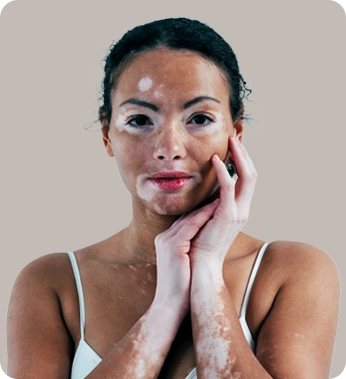
Dr Batra's® homeopathic treatment for vitiligo offers a natural and holistic approach. It targets the root cause and focuses on symptom management. This comprehensive approach promotes lasting results and overall well-being
Do you know? Vitiligo affects around 0.5% to 2.5% of India’s population, with some regions reporting a prevalence as high as 8.8%. Most cases appear before the age of 20, highlighting the importance of early intervention. Despite its visibility, vitiligo is non-contagious and can be effectively managed through holistic care
Stimulates Melanin Production
Restores natural pigmentation with quicker results in fleshy areas compared to bony regions
Strengthens Immune Defense
Strengthens immunity to protect melanocytes & minimise the spread of depigmentation
Reduces the spread of Depigmentation
Addresses underlying triggers to slow the progression of depigmented areas
Manages Stress and Emotional Factors
Treats emotional stress and nutritional deficiencies that can worsen vitiligo
To achieve optimal results with alopecia homeopathic remedies, it is essential to follow a comprehensive care plan. Here’s a step-by-step process:
Safe for All Ages
Natural remedies with no side effects
Personalised Care
Personalised treatment based on your unique medical history
Long-Term Relief
Supports pigment reduction and minimises recurrences

Advanced Diagnostic Tools
Dr Batra’s® Wood’s Lamp technology backed by AI provides an accurate way to assess and monitor your skin health
Tailored Treatment Plans
Each patient receives a tailored approach based on their medical history and lifestyle
40+ Years of Expertise
Decades of successful experience treating vitiligo naturally
Proven Results
Thousands of satisfied patients with visible improvements in their condition
Holistic Care
Combines homeopathic remedies with dietary counselling and emotional support
Use Sunscreen
Protect depigmented areas from UV damage
Avoid Skin Trauma
Prevent injuries and irritation
Eat a Balanced Diet
Include foods rich in zinc, vitamin B12, and antioxidants
Manage Stress
Practice meditation or yoga to stay calm
Gentle Skincare
Use mild, fragrance-free products
Medically reviewed by

Dr. Vaishali Kamat
20+ years of experience
Vitiligo is an autoimmune disease. It can be managed with safe, natural, and side-effect-free treatments. It is a lifelong condition for patients who suffer from it. Homeopathy helps reduce pigmentation and prevent further spread. Vitiligo has no cure, but treatment can bring hope
The timeline for results varies depending on the treatment and individual response. Some vitiligo patients may notice improvements within weeks, while others may need several months of consistent therapy to see noticeable changes. Patient adherence to the treatment plan is key to achieving optimal results.
Homeopathic treatments are generally safe and free from side effects. Since they use natural remedies to treat vitiligo, they are gentle on the body. Consult a qualified homeopath to ensure the proper treatment and dosage for individual needs, ensuring a safe experience
Yes, homeopathic treatment is gentle and effective for children suffering from vitiligo. Homeopathy offers safe, natural remedies that are gentle and tailored to the child’s individual needs. Consult a homeopath to ensure the treatment is appropriate and effective for the child’s age and condition
Genetics can play a role, but homeopathy can help manage hereditary triggers. 30% of people with this condition will have a family history of vitiligo. Hence, children will not get vitiligo strictly because a parent has it. However, they do stand a high chance of developing the condition
Effective homeopathic medicines for vitiligo include Arsenicum Album, Silicea, Baryta Carb, Sulphur, Natrum Muriaticum, and Calcarea Carbonica